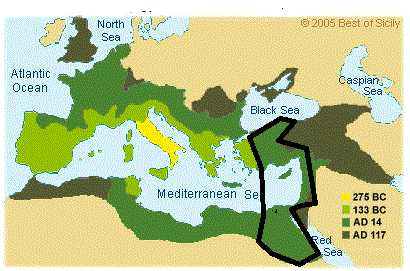<A>
Eastern border of the Empire: *
Map of the Roman Empire; the section within the red
outline shows the eastern periphery of the Empire in 14 AD,
the time in which Spengler asserts the birth of the Magian
Culture.
This periphery would include Alexandria and Byzantium, but
many other areas, such as Persia (Parthia), Armenia,
Arabia & Axum were located outside this region.


<B>
Riegl: *
His reputation was established by "Problems of style: foundations for a history of ornament" (1893). He refutes the materialist account of the origins of decorative motifs (e.g., the weaving of textiles) & instead describes a continuous & autonomous "history of ornament." He studied ornamental motifs, such as the arabesque, from ancient near eastern through classical and up into early medieval and Islamic art. This led to his idea of "will to art" a historically contingent tendency of an age/nation that drove stylistic development without respect to mimetic or technological concerns. This publication led to a position at the University of Vienna (1894) where he began lecturing on Baroque art (then seen as the decadent end of the Renaissance). In 1901 he published "Late Roman art industry", where he characterized late antique art through stylistic analyses of its major monuments (e.g. the Arch of Constantine) and also everyday objects such as belt buckles. This book followed the lead of (his colleague) Wickhoff‘s Die Wiener Genesis. These were the first to consider aesthetic characteristics of late antique art on their own terms rather than as a collapse of classical standards. From this arose the Riegl/Wickhoff and Strzygowski debate concerning the origins of the late antique style.
"Late Roman art industry" was a philosophical justification for ”the will to art” or Kunstwollen. All human will is directed toward a satisfactory shaping of man's relationship to the world. It regulates man's relationship to the sensibly perceptible appearance of things; art expresses the way man wants to see things shaped. It is reflected in the broadest sense, in religion, philosophy, science, statecraft, law. Through this Will, art becomes the expression of a desired reality. By means of this theoretical apparatus he could penetrate to the essence of a culture through formal analysis of its art.
His legacy is visible it the “the will-to-art”. Primitive, "ornamental" art, represents a social belief in the abstract soul & not a lack of naturalism. His urge to abstraction (the idea of artistic volition) displaced the notion that art history is about progress from primitive skills to modern skills. He held a relativist approach: what we see as distortion might at the time have been seen as the highest beauty. He is credited with psychological insight: art can be interpreted as parallel to forms of belief in the soul. His work foreshadowed concerns of contemporary art history: his insistence that aesthetics be treated in historical context, not in relation to some ideal standard; his interest in the "minor" arts; his attention to the relationship between viewers and objects.
<C>
Armenia…et all:
see map below covering 6 regions & cites (Armenia, S Arabia, Axum, Persia, Byzantium, Alexandria)
the Kingdom of Axum, a kingdom in N Ethiopia & Eritrea, ruled by the Aksumites (100- 940 AD); capital Axum, settled in Iron Age & grew from 4th century BC onward, becoming prominent by the 1st century AD. Major player in commerce between the Romans & India. The Aksumite rulers facilitated trade by minting their own Aksumite currency. They regularly got involved in the kingdoms on the Arabian Peninsula eventually extending its rule with the conquest of the Himyarite Kingdom. The Manichaei prophet Mani (died 274 AD) regarded Axum as 1 of the 4 great powers of his time (along with Persia, Rome & China)
The Parthian Empire (247 BC-224 AD) Iranian political & cultural power, Persian; founded in mid 3rd century BC by the Parni tribe when it conquered the NW region of Iran (during a rebellion against the Selecids). Mithridates I (171-38 BC) expanded the empire by seizing Media & Mesopotamia from the Seleucids. At its peak the Empire stretched from the N Euphrates to E Iran. Located on the Silk Road between the Roman Empire & the Han Empire of China, it benefitted from trade & became a centre of commerce.
The Kingdom of Armenia (321 BC-428 AD). Originally a satrapy of the Achaemenid Empire; following Alexander’s conquest of Persia in 321 it became a kingdom. It was incorporated into the Seleucid Empire (312-63 BC). The Armenian throne was retained. During the Roman Republic's eastern expansion, Armenia, under Tigranes the Great, dominated the region, from 83 to 69 BC, conquering the remaining territories of the Seleucid Empire. In 69 BC it was itself conquered by Rome, the Armenian kings ruling as clients of Rome until they were overthrown in 12 AD owing to a conspiracy with the Parthians. During the Roman–Parthian Wars (66 BC – 217 AD), Armenia was a contested territory. From 114-18 it was a province of the Roman Empire under Trajan. Later it would serve as a frontier client state of the Byzantine & Sassanid empires. In 301 Christianity became the state religion of Armenia, (making it the first state to embrace Christianity officially).
Compare this map with the map of the Romam Empire showing the eastern frontier. Only 2 points lie within the empire (Alexandra & Byzantium), 3 regions lie far outside and 1 region (Armenia) straddles the Empire frontier.
